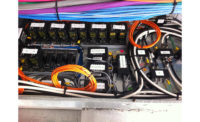From Surveillance to Safety & Other Niche Jobs for IP Cameras
IP cameras, especially those paired with AI, are in a prime position to capture some of the market growth in safety and other specialized applications.

License plate recognition when combined with IDIS edge AI cameras is improving the safety of both customers and vehicles at a parking garage. Customers equipped with IDIS mobile apps are alerted with video clips to any damage to vehicles. IMAGE COURTESY OF IDIS
IP cameras, in all their many forms, are getting more powerful every day. It’s not because they’re becoming more complex; rather, IP cameras are becoming more open to development themselves or by third parties — and that makes them more useful and effective.
It also allows IP cameras to excel at some incredibly niche applications, which go well beyond the scope of traditional “security surveillance.” Most security professionals are familiar with using video analytics to produce marketing intelligence reports, common in the retail realm. In other roles, IP cameras with advanced analytics are helping organizations manage their facilities, operations and staff.
Now a relatively new niche application for IP cameras is surfacing: safety. This could mean safety in an indoor environment like a manufacturing plant, where cameras can detect both potential and actual injuries on site. Or safety outdoors, too. Imagine using an IP camera to measure the level of a river to ultimately give advance warning of flooding.
Video cameras already excel at capturing data. In combination with artificial intelligence and IoT sensors they present a very powerful solution for detecting and alerting to many types of specific situations such as safety. In fact, it was one of the topics discussed in sessions at this year’s ISC West conference.
“It is incumbent on integrators to educate customers on all the other things they can do with IP video data,” describes Satish Raj, chief technology officer, Pro-Vigil, San Antonio, Texas. “Installing IP cameras not only makes the customer more secure, but it also ‘future proofs’ them so they can do all sorts of other things with the IP video in the future — whether that’s safety applications or newer applications like measuring traffic flows. Ultimately, your business is to sell IP cameras, but these applications provide a whole new selling-point beyond security.
Pro-Vigil provides AI-enabled remote video monitoring solutions to organizations from its UL-listed and Five Diamond designated monitoring center. Some of the growth potential Raj references stems from when businesses used AI video technology during the pandemic to monitor social distancing and masking requirements.
“Pairing IP cameras with AI is allowing organizations to automate monitoring of many safety and regulatory requirements, including these new use cases in recent years,” Raj describes.
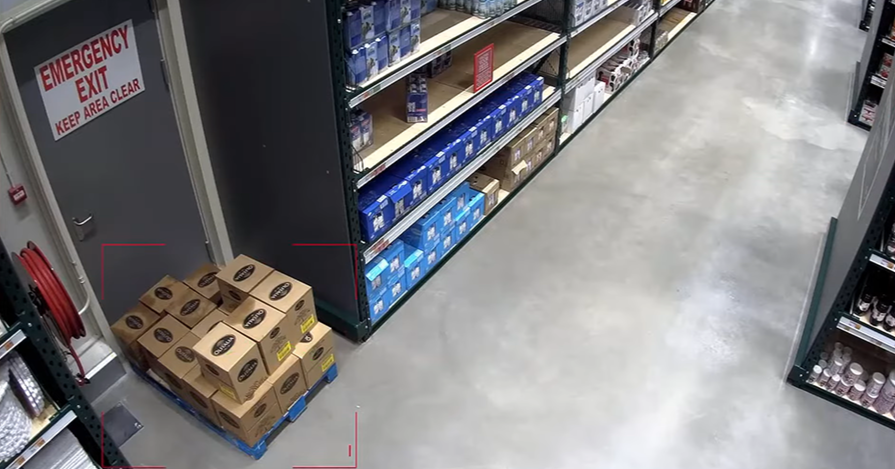
Monitoring On-the-Job Safety
IP cameras with edge-based, server-based or cloud-based analytics can support an end user’s compliance with health and safety directives and regulatory requirements in several ways.
For example, analytics can detect an object blocking an emergency exit door or a vehicle parked in a fire lane. “If integrated with the building’s public address system or an IP-based horn loudspeaker, the analytics can trigger a warning message to notify the person to move the object or vehicle,” says Matt Cirnigliaro, regional marketing manager – analytics, Bosch Security and Safety Systems, Fairport, NY.
Emerging AI-driven analytics technology can also enable IP cameras to detect the proper use of personal protective equipment (PPE) and alert when items are missing, Cirnigliaro says. This can include safety vests, helmets or hardhats, eyewear, gloves and masks.
In addition to ensuring workers are wearing appropriate safety gear in industrial and manufacturing settings, IP cameras with AI can detect if someone has entered a restricted area. When a worker crosses a preset virtual line, pre-recorded audio alerts can be triggered. One such example is hygiene reminders ensuring that standards are met for hairnets, caps, aprons, or masks in food and pharmaceutical production, explains Jason Burrows, sales director, IDIS Americas, Coppell, Texas.
One of the most common safety concerns in the logistics and warehousing space is injuries caused by the misuse of or accidents involving forklifts or side-loaders, Burrows says. These can be addressed by specially designed onboard pinholes and compact NVRs — one solution — that alert drivers to potential hazards and alert supervisors to poor safety practices.
“It’s important that integrators focus on security, but equally so to engage with heads of safety and operations; the estimated cost of forklift accidents involving injured workers can be as high as $38,000 in direct costs per injured worker and $150,000 in indirect costs,” Burrows says.
When assessing which attributes of IP cameras would make them work well in safety applications, a good place to start is with image quality.
“Cameras require few features and should focus on what they’re good at — capturing high-quality video in a well-lit environment,” says Satish Raj at Pro-Vigil. “If a camera can’t see, it’s useless. All the AI and analytics capabilities in the world can’t compensate for an obscured picture.”
Ideally the camera should perform well in low light because many obscure areas, such as interiors of large commercial buildings, may not be well lit.
Michael Schutt, marketing manager, Speco Technologies, Amityville, NY, says that while its IP cameras can be used in any application, there are models that may be better than others in certain applications. “For example, if you have an area with low light your best option would be to go with our White Light Intensifier models because they allow you to see color in low-lit areas,” he explains.
Burrows says, “The latest IDIS edge AI cameras empower operators with IDIS Lightmaster NIR CMOS image sensors to capture footage at night or in challenging light conditions to ensure crisp, clear images without compromise or any impact on AI analysis.”
But camera hardware is only half of the story. There’s also the software, as the cameras can be equipped with AI analytics packages based on the intended use, says Matt Cirnigliaro of Bosch — which, in the following example, is safety:
“The edge-based video analytics should be designed to accurately detect an object blocking an exit, a vehicle parked in a fire lane, a person missing PPE items, or the presence of pedestrians in or near the roadway. The analytics must be robust enough to deliver the high level of accuracy that is required for safety applications, while ignoring potential disturbances caused by headlights, extreme weather, sun glare, vibration or shake.”
Only with artificial intelligence can the cameras utilize their full potential for safety applications. The AI can be on the edge (camera), on a server, or in the cloud. The ability for AI to continue learning what to detect makes them even more valuable to users.
For example, most cameras using AI can detect dozens of details about humans and vehicles. But customers may have additional, very specific detection needs — for example, recognizing a logo on the side of an arriving truck or alerting when a forklift is moved into a certain area. i-PRO’s X Series cameras have an on-site AI learning feature that allows customers themselves (or integrators on behalf of their customers) to teach the cameras about custom objects they wish to identify and search for or track, says Hiroshi (Huey) Sekiguchi, i-PRO Co Ltd.
Another important aspect of the X Series camera is its AI Processing Relay that allows users to add AI capabilities to up to three existing, non-AI surveillance cameras — even cameras from other manufacturers, Sekiguchi says. The X Series camera passes the video streams from those three other cameras, in addition to its own, onto the VMS. One of the benefits of this feature is that it lets integrators and end users try out AI with a smaller financial investment at the outset.
In the future cameras will gain greater intelligence through the pairing of additional types of sensors and a “fusion of AI,” says Aaron Saks, director of product training, Hanwha Vision America, Teaneck, NJ. “For example, cameras or audio sensors are being AI-enabled, allowing them to more accurately detect certain scenarios based on the monitored audio alone, while ignoring false positives. Thermal and bi-spectrum cameras are gaining AI capabilities, allowing them to provide thermal imaging with AI detections. In the future, we will see this continue to devices such as radar or LiDAR sensors and beyond.
“The AI models will also become more specialized, allowing a customer to choose what they want to detect, allowing for vertical specialization without needing a specialized camera, such as detecting shopping carts, forklifts, etc.,” Saks describes.
Improving Personal Safety in Everyday Life
In healthcare and assisted-living facilities, falls are a core concern. If patients are left untreated for any length of time, it can result in a serious injury, Burrows says. “By using AI video analytics, hospitals and home-care organizations can improve safety measures, prevent accidents, and respond quickly to emergencies,” he says.
In public spaces, AI is being used to identify accidents and alert authorities to initiate any needed first-aid response, he describes. In a parking garage, customers are equipped with IDIS mobile apps, which alert them with video clips to any damage caused to their vehicles. “Should there be damage, customers and the parking operator have the video evidence they need to identify and apprehend criminals or vandals, as well as for insurance claim purposes,” he says.
IP cameras with edge analytics are being used for pedestrian safety applications in smart cities. In a Bosch application, the city of Peachtree Corners, GA, has implemented systems to improve vulnerable road user (VRU) safety at two intersections where a walking and biking trail intersects with a street, Cirnigliaro says. These systems use cellular-vehicle-to-everything (CV2X) technology, which enables communication between vehicles, from vehicles to infrastructure, and vehicles to VRUs.
“Bosch cameras with AI-driven analytics accurately detect and distinguish VRUs and vehicles, even in congested scenes or dense traffic. When the cameras detect VRUs in the crosswalk, they trigger a roadside controller from a Bosch partner to create CV2X personal safety messages that are broadcast to connected vehicles. This VRU alert is sent to vehicles 150 yards before they enter the intersection, giving the driver time to react accordingly,” Cirnigliaro says.
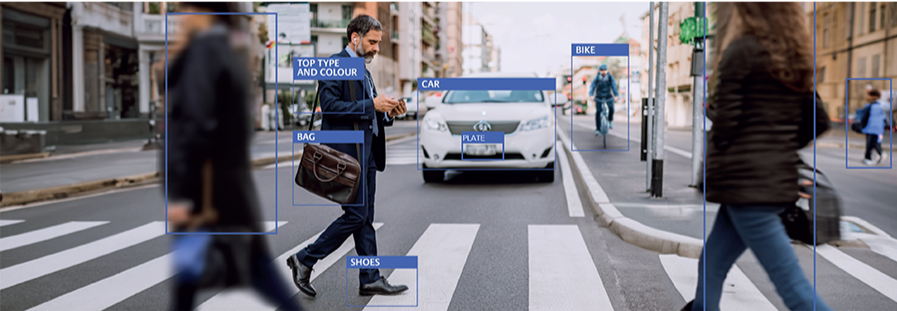
Video Monitoring of Extreme Weather
One of the most advanced applications for IP cameras and AI analytics is their use in monitoring extreme weather, such as flooding caused by heavy rain, snow storms and wildfires. It is the topic of a recent blog posted by Axis Communications. Several surveillance companies also have successful applications.
“Video surveillance, environmental sensors, and analytics are being increasingly used by authorities to give early warning of potential disasters and support the most rapid and effective response” writes Andrea Sorri, segment development manager Smart Cities EMEA, Axis, in the blog. “More specifically, security cameras can be used to monitor high risk areas, collect real-time weather data and generate automatic warnings for specific changes that may signal the advent of an extreme event.”
The author gives examples of several weather events including flooding and wildfires. In flooding applications authorities use underwater flow sensors to detect the likelihood of flooding, and security cameras to measure water height and surface flow speed in the image feed, among other solutions. To address potential wildfires, security cameras are monitoring for flare-ups in remote areas and providing location information. “… Video analytics can detect smoke plumes as well as provide an estimation of the distance of a plume from the camera itself,” the author describes.
In geographically rich Japan, the country’s protracted ocean coastlines, vast number of rivers, and steep mountains necessitate the use of video cameras and sensors to respond to natural events to keep people safe, says Hiroshi (Huey) Sekiguchi, chief marketing officer, i-PRO Co Ltd., Houston, Texas (Americas headquarters). These rivers flow very steeply and swiftly from the mountains down to the coasts. In a heavy rainfall the downstream rivers can be a source of destructive flooding; video monitoring can provide early warnings of that potential.
Modular cameras, sometimes called board cameras, are often overlooked for their adaptability for several niche applications. Not only have they long been a staple of covert surveillance jobs, but they’re also used in ATMs, mobile surveillance, and more.
A modular camera has two main, but separate, parts — a main or remote unit and a sensor or “the eyes” — which can be installed in different locations and connected via wired or wireless means. The main unit contains the brains of the camera, as well as any I/O ports, USB ports, network and/or power connections. Depending on the main unit, there can be anywhere from one to four “eyes,” which could be a standard mini-dome, a fisheye sensor, a pinhole sensor or other types, notes Robert Brown, solutions engineer, Axis Communications, Chelmsford, Mass. “This provides a great deal of flexibility,” he says.
A common method for connecting the sensor and main unit is a wired connection. A USB or Ethernet cable may transmit video, control signals, and power. Wireless connections are used in Wi-Fi and Bluetooth settings, explains Michael Schutt, marketing manager, Speco Technologies, Amityville, NY.
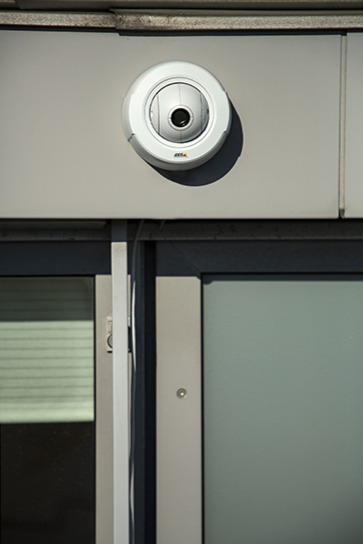
“This allows for flexible installations and remote access to the camera. Finally, network integration is ideal for IP-based camera systems that connect to a network via Ethernet or Wi-Fi,” he says. Speco Technologies sells a wide variety of board cameras that include a 2.8mm fixed lens and come in turret, dome and bullet models.
One of the primary applications for modular cameras is for covert surveillance — and one of the most common sensor types used is the “pinhole.” With their small size they can be hidden practically anywhere. “A covert camera will be used whenever you want a suspect to change their behavior based on the false assumption that they are not seen on camera,” Brown says.
He gives an example of a covert camera installed at eye level in a door mullion; it can capture a suspect’s face as they walk through an entrance, even if they’re wearing a baseball cap and looking down. “A suspect might also feel confident hiding merchandise inside their clothing if they think nobody can see them in a back corner of a store, where there aren’t any cameras in the ceiling near them,” Brown says.
Jason Burrows at IDIS Americas says the electronic components and very small lens or aperture used in pinhole security cameras allows for more precise control over the image quality and light sensitivity. They are typically connected to a recording device or network and store footage locally on memory cards or transmit it to a remote server or recording device via wired or wireless connections, he describes.
“Pinholes are an ideal tool to tackle shrinkage, especially in luxury retail, as they can be inserted into display cases and easily disguised among jewelry and watches to enhance security. This allows detailed monitoring without impacting store aesthetics or the customer experience with overt security measures,” Burrows says.
They also can be used temporarily by loss prevention managers to monitor for shrinkage, because they are quick and easy to install during off-hours in stock room shelving, Burrows adds.
Another application for a modular camera is an ATM, which could gain from having multiple pinhole sensors — one to view customers outside and another to view any service work being done inside the machine.
Any application that has a tight fit, such as a network cabinet in an IT room or data center, are ideal for a small-form-factor camera sensor, such as a pinhole. In fact, whether or not covert surveillance is the objective, pinhole cameras will work well anywhere the customer does not want cameras to detract from the aesthetics.
Other niche applications for these mighty, but small cameras are vehicle security, as well as anywhere that integrators want to take advantage of products that accommodate multiple camera sensors attached to only one main unit, such as both the F series and FA series which Axis offers.
Japan has deployed approximately 9,000 cameras to monitor the status of its rivers, and has indicated its interest in adding more technology in the coming decade, Sekiguchi notes. In the larger rivers, the country is using sensors and cameras to detect water levels and alert authorities of any significant changes.
But there is a greater need to monitor the smaller, upstream rivers, many of which aren’t suitable for water-level sensors due to their normally shallow status. “There’s very high interest in adding more analytics, such as [detection of] falling rocks or a sudden flow of water, to cope with these rivers as well as other disasters like mudslides,” Sekiguchi says.
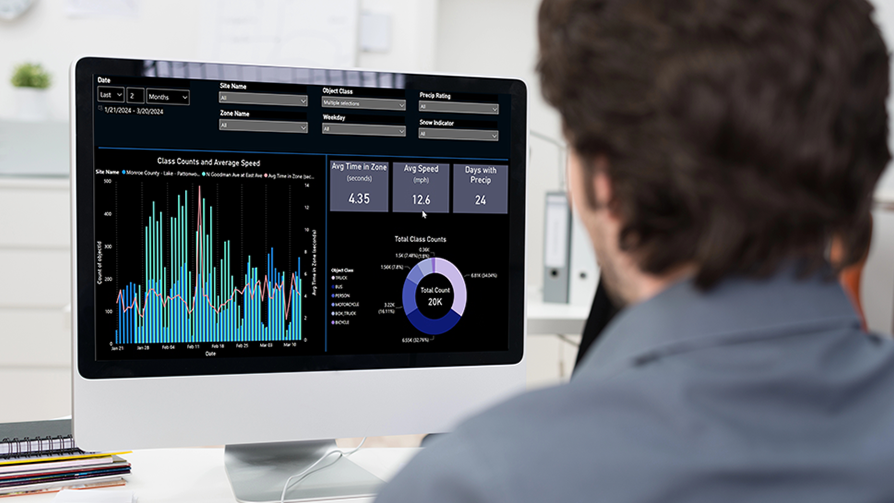
“When we face rainfall in a very short time, that small stream suddenly becomes wide and deep. It’s so crucial to detect things earlier, not after. Once you see an increase in your water height in those larger rivers, it’s too late because the water actually came from upstream and there already may be flooding upstream. Now you have to evacuate all the downstream people,” he says.
Sekiguchi says that concerning niche applications such as these, it’s important that the cameras are open to third-party applications. One way to make that easier is by supporting Docker Container, which is an isolated environment for your code. According to Docker, a container “has no knowledge of your operating system or your files. It runs on the environment provided to you by Docker Desktop. Containers have everything that your code needs in order to run, down to a base operating system.”
i-PRO just announced its support of Docker Container on its X Series line of AI cameras. “There are many companies that are using tools to create algorithms for AI and they’re using Docker Container a lot,” he explains. “It is much easier … to deploy directly to the camera. Docker Containers [provide] … a standardized way for application developers to rapidly advance the AI capabilities of i-PRO edge devices.”
It is with this and other technologies that security integrators are finding new opportunities for growth outside of traditional security surveillance. “Cameras equipped with application-specific analytics are making it easier for integrators to apply this technology to solve common safety-related challenges in markets that are increasing spending in this area,” says Cirnigliaro at Bosch.
“Although IP cameras still do security extremely well, integrators need to understand that IP cameras can do much more,” says Raj at Pro-Vigil. “Their customers are much more likely to buy something that can provide a broad array of value moving forward, than they are buying a single-purpose solution.”
Looking for a reprint of this article?
From high-res PDFs to custom plaques, order your copy today!





